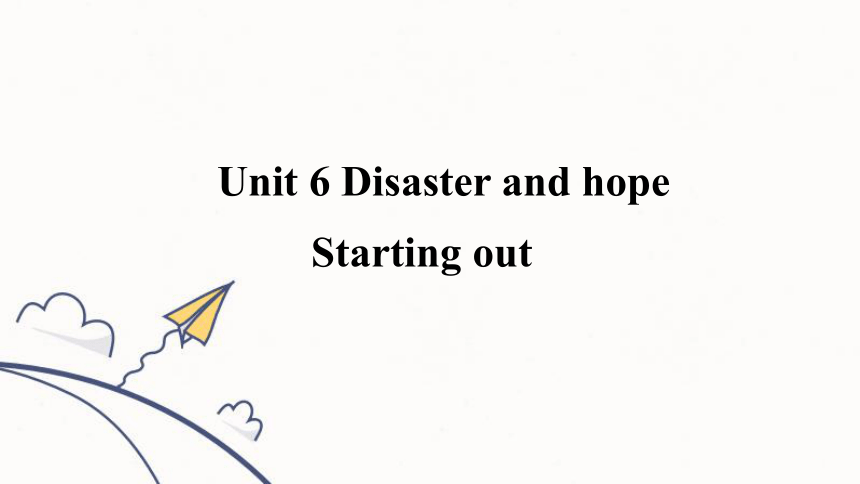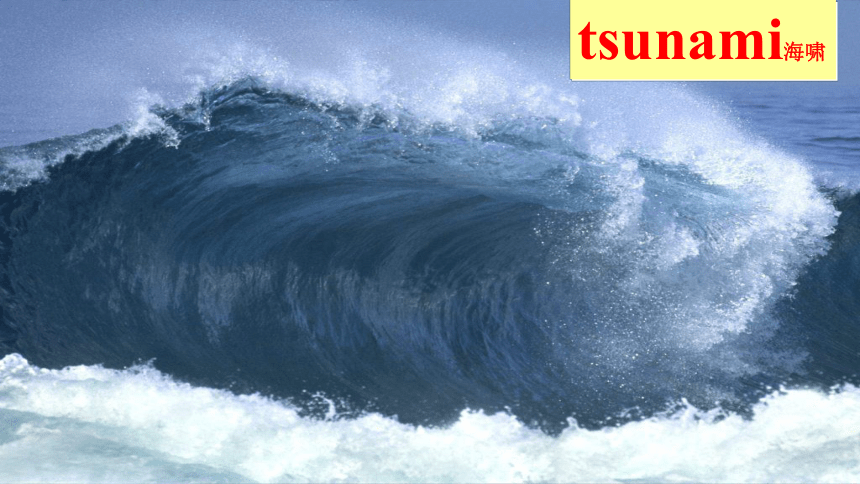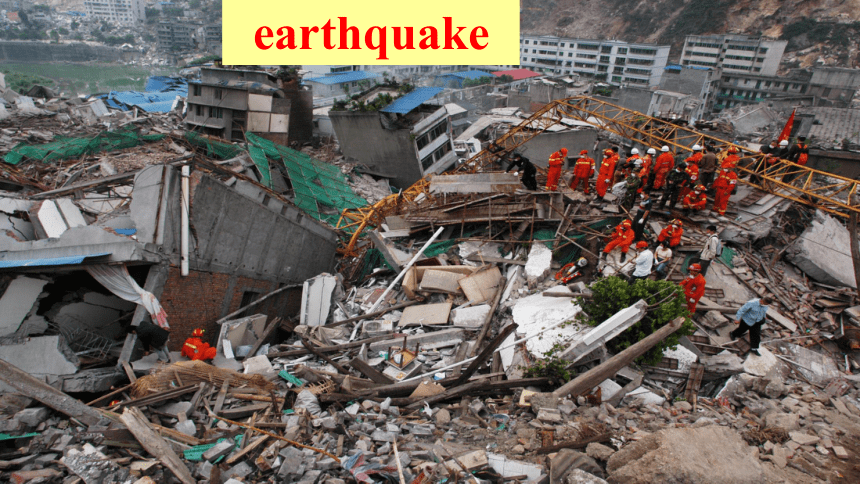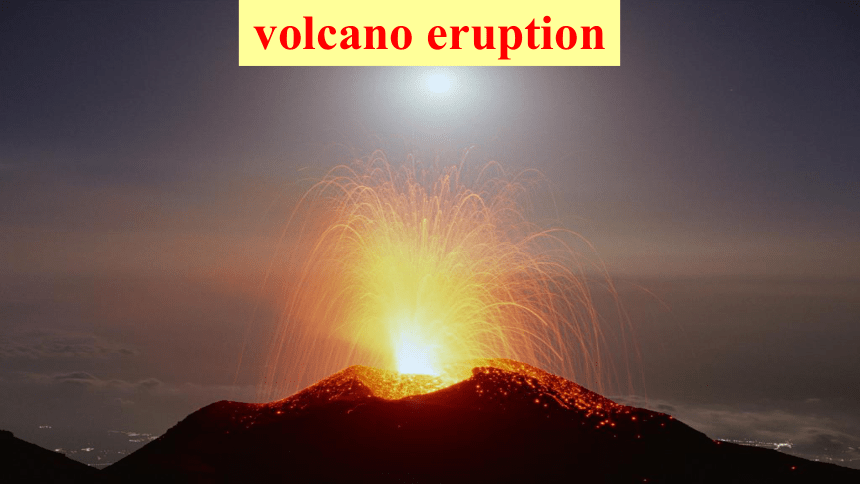Unit 6 Disaster and hope Starting out(共37张,内嵌视频)2024-2025学年高一英语外研版(2019)必修3
文档属性
| 名称 | Unit 6 Disaster and hope Starting out(共37张,内嵌视频)2024-2025学年高一英语外研版(2019)必修3 |  | |
| 格式 | pptx | ||
| 文件大小 | 52.2MB | ||
| 资源类型 | 教案 | ||
| 版本资源 | 外研版(2019) | ||
| 科目 | 英语 | ||
| 更新时间 | 2025-05-02 10:55:32 | ||
图片预览












文档简介
(共37张PPT)
Starting out
Unit 6 Disaster and hope
By the end of this class, you will be able to
1. Know about the usage of some expressions about disaster;
2. Develop environmental awareness and make efforts to protect our planet.
Learning objectives
Do you know these natural disasters
flood
A lot of water in an area which is usually dry.
thunderstorm
A lot of rain falling quickly, with loud noises and flashes of light.
A very strong wind or storm.
hurricane
tornado
typhoon: tropical storm
gale狂风;海上风暴
tsunami海啸
earthquake
sandstorm
dust storm
snowstorm
drought
landslide
snow slide
= avalanche
/ v l nt /雪崩
fire
volcano eruption
Hail冰雹
debris flow泥石流
How do we describe natural disasters
subjective
disastrous
(灾难性的)
horrible
scary
shocking
frightening
heartbreaking
(心碎的)
disgusting
terrifying(极可怕的)
catastrophic(惨重的)
objective
surprising
splendid
unpredictable
(不可预测的)
impressive
unforgettable
incredible
(不可思议的)
unbelievable
Activity 1 Watch the video and answer the questions.
1 Where is the city What happened there
2 How did people there react to the disaster What was the result
1 Where is the city What happened there
The Roman city was in Italy.
It was close to a volcano and in the year 79 AD, the volcano erupted, and the city was destroyed.
Mount Vesuvius
Ruins of Pompeii
Activity 1 Watch the video and answer the questions.
2 How did people there react to the disaster What was the result
Bodies were found in the same positions in which they fell.
People there were frightened by the sudden disaster. They took what they could as they tried to get away from the city.
Many people were trapped by the buildings that were falling down, and killed by the powerful flow of gas, ash and rock.
Pompeii
Pompeii was an Ancient Roman city in Italy . It is believed that the city was founded in the 7th or 6th century BC. The eruption of Mount Vesuvius (维苏威火山)in 79 AD destroyed the city, killing its residents and burying it under tons of ash. The site was lost for centuries before its ruins were discovered in the late 16th century and broader rediscovery in the mid-18th century. Today Pompeii has UNESCO World Heritage Site status (联合国教科文组织列为世界遗产)and is one of the most popular tourist attractions in Italy, attracting millions of visitors each year.
What are the films about What can we learn from them
What other stories do you know about natural disasters
[p said n]
《唐山大地震》
《后天》
《海神号》
《不惧风暴》
Activity 2 Look at the film posters and answer the questions..
The Day After Tomorrow (后天) is a 2004 American science-fiction disaster film, which talks about the destructive effect of global warming and warns us human beings that it is high time that we took action to protect the environment.
Disaster films
The Day After Tomorrow
Disaster films
Into the Storm (不惧风暴) is a 2014 American disaster film, which tells the story of tornado-stricken Silverton, Oklahoma.
It shows that people suffering from the tornadoes express a new-found appreciation for their lives.
Into the Storm
Aftershock (唐山大地震) is a 2010 Chinese emotional and disaster film, which is set in the 1976 Tangshan earthquake and tells a story of “23 seconds and 32 years”.
The film shows the cruelty of the disaster and the love among families.
Disaster films
Aftershock
Poseidon (海神号) is a 2006 American action and disaster film, which is set in a giant ship overturned by a tsunami. It tells a story of the people trapped in the ship trying to find a way to survive.
The film shows the strength of human nature in the face of disaster.
Disaster films
Poseidon
Activity 3 Choose a disaster and write a list of safety instructions.
tornado tsunami earthquake wildfire flood
First/First of all, you should…
Stay calm.
Don’t drive or walk outside.
Collect water and food if you can.
Cover your…
Listen to the news.
Move to a safe place.
Finally,…
Call an emergency number.
Stay away from…
Make sure…
Stay indoors.
If you’re trapped…
Remember to…
Use… to call for help.
Tornado/Hurricane
Know where you can take shelter in the house, for example, bathroom, storage rooms, get away from the windows.
Store protective coverings, like sleeping bags, thick blankets, etc.
Make sure the safety supplies are handy.
Turn on TV and radio, stay alert for warnings.
If you are outdoors, run into shopping center, hospital, stadiums, or any safe and nearby shelter area.
Tsunami
If you hear tsunami warning, evacuate at once.
Go as high and as far as you can — at least to a spot 30 meters above sea level or 2 miles away.
Take your emergency kit.
Drop, cover, and hold on to protect yourself from the possible earthquake.
Avoid downed power lines and stay away from buildings and bridges from which heavy objects might fall during an aftershock.
Earthquake
Prepare a basic disaster supplies kit and find a safe place.
Drop down immediately.
Take cover under a desk, table and hold on.
Cover your head and neck with your hands. Stay away from windows, or furniture that can fall on you.
If you are outdoors, find a clear spot away from trees, buildings, and power lines; drop to the ground and cover head and neck.
Wildfire
Gather emergency supplies.
If trapped, call 119, give your location and turn on lights to help rescuers find you.
Use masks or wet towels to help you breathe and keep smoke outside.
Flood
Gather emergency supplies.
Leave areas subject to flooding: low spots.
Avoid driving through flooded areas and standing water.
Turn off all main power switch and gas.
Describe a natural disaster.
1. Which natural disaster
2. Where and when did it take place
3. What were the effects
4. What was done to improve the situation those affected by the disaster
5. How did it make you feel
Homework
Starting out
Unit 6 Disaster and hope
By the end of this class, you will be able to
1. Know about the usage of some expressions about disaster;
2. Develop environmental awareness and make efforts to protect our planet.
Learning objectives
Do you know these natural disasters
flood
A lot of water in an area which is usually dry.
thunderstorm
A lot of rain falling quickly, with loud noises and flashes of light.
A very strong wind or storm.
hurricane
tornado
typhoon: tropical storm
gale狂风;海上风暴
tsunami海啸
earthquake
sandstorm
dust storm
snowstorm
drought
landslide
snow slide
= avalanche
/ v l nt /雪崩
fire
volcano eruption
Hail冰雹
debris flow泥石流
How do we describe natural disasters
subjective
disastrous
(灾难性的)
horrible
scary
shocking
frightening
heartbreaking
(心碎的)
disgusting
terrifying(极可怕的)
catastrophic(惨重的)
objective
surprising
splendid
unpredictable
(不可预测的)
impressive
unforgettable
incredible
(不可思议的)
unbelievable
Activity 1 Watch the video and answer the questions.
1 Where is the city What happened there
2 How did people there react to the disaster What was the result
1 Where is the city What happened there
The Roman city was in Italy.
It was close to a volcano and in the year 79 AD, the volcano erupted, and the city was destroyed.
Mount Vesuvius
Ruins of Pompeii
Activity 1 Watch the video and answer the questions.
2 How did people there react to the disaster What was the result
Bodies were found in the same positions in which they fell.
People there were frightened by the sudden disaster. They took what they could as they tried to get away from the city.
Many people were trapped by the buildings that were falling down, and killed by the powerful flow of gas, ash and rock.
Pompeii
Pompeii was an Ancient Roman city in Italy . It is believed that the city was founded in the 7th or 6th century BC. The eruption of Mount Vesuvius (维苏威火山)in 79 AD destroyed the city, killing its residents and burying it under tons of ash. The site was lost for centuries before its ruins were discovered in the late 16th century and broader rediscovery in the mid-18th century. Today Pompeii has UNESCO World Heritage Site status (联合国教科文组织列为世界遗产)and is one of the most popular tourist attractions in Italy, attracting millions of visitors each year.
What are the films about What can we learn from them
What other stories do you know about natural disasters
[p said n]
《唐山大地震》
《后天》
《海神号》
《不惧风暴》
Activity 2 Look at the film posters and answer the questions..
The Day After Tomorrow (后天) is a 2004 American science-fiction disaster film, which talks about the destructive effect of global warming and warns us human beings that it is high time that we took action to protect the environment.
Disaster films
The Day After Tomorrow
Disaster films
Into the Storm (不惧风暴) is a 2014 American disaster film, which tells the story of tornado-stricken Silverton, Oklahoma.
It shows that people suffering from the tornadoes express a new-found appreciation for their lives.
Into the Storm
Aftershock (唐山大地震) is a 2010 Chinese emotional and disaster film, which is set in the 1976 Tangshan earthquake and tells a story of “23 seconds and 32 years”.
The film shows the cruelty of the disaster and the love among families.
Disaster films
Aftershock
Poseidon (海神号) is a 2006 American action and disaster film, which is set in a giant ship overturned by a tsunami. It tells a story of the people trapped in the ship trying to find a way to survive.
The film shows the strength of human nature in the face of disaster.
Disaster films
Poseidon
Activity 3 Choose a disaster and write a list of safety instructions.
tornado tsunami earthquake wildfire flood
First/First of all, you should…
Stay calm.
Don’t drive or walk outside.
Collect water and food if you can.
Cover your…
Listen to the news.
Move to a safe place.
Finally,…
Call an emergency number.
Stay away from…
Make sure…
Stay indoors.
If you’re trapped…
Remember to…
Use… to call for help.
Tornado/Hurricane
Know where you can take shelter in the house, for example, bathroom, storage rooms, get away from the windows.
Store protective coverings, like sleeping bags, thick blankets, etc.
Make sure the safety supplies are handy.
Turn on TV and radio, stay alert for warnings.
If you are outdoors, run into shopping center, hospital, stadiums, or any safe and nearby shelter area.
Tsunami
If you hear tsunami warning, evacuate at once.
Go as high and as far as you can — at least to a spot 30 meters above sea level or 2 miles away.
Take your emergency kit.
Drop, cover, and hold on to protect yourself from the possible earthquake.
Avoid downed power lines and stay away from buildings and bridges from which heavy objects might fall during an aftershock.
Earthquake
Prepare a basic disaster supplies kit and find a safe place.
Drop down immediately.
Take cover under a desk, table and hold on.
Cover your head and neck with your hands. Stay away from windows, or furniture that can fall on you.
If you are outdoors, find a clear spot away from trees, buildings, and power lines; drop to the ground and cover head and neck.
Wildfire
Gather emergency supplies.
If trapped, call 119, give your location and turn on lights to help rescuers find you.
Use masks or wet towels to help you breathe and keep smoke outside.
Flood
Gather emergency supplies.
Leave areas subject to flooding: low spots.
Avoid driving through flooded areas and standing water.
Turn off all main power switch and gas.
Describe a natural disaster.
1. Which natural disaster
2. Where and when did it take place
3. What were the effects
4. What was done to improve the situation those affected by the disaster
5. How did it make you feel
Homework
